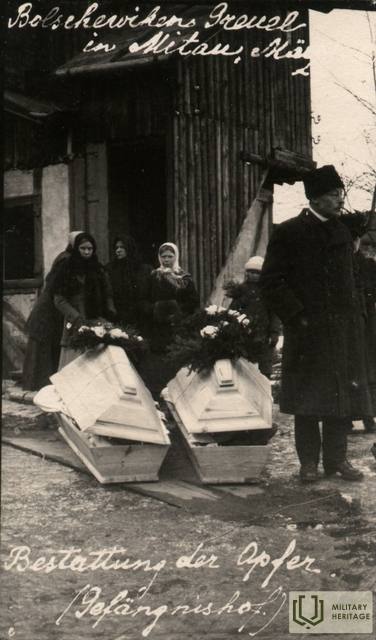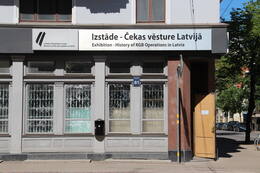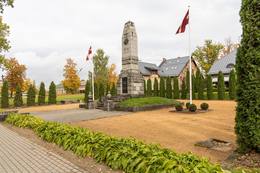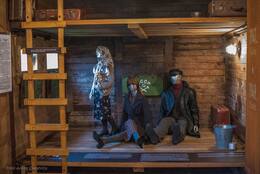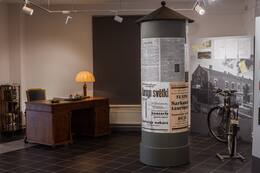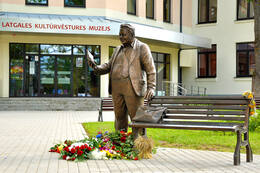Raudonasis teroras I WW1, I Nepriklausomybės karai
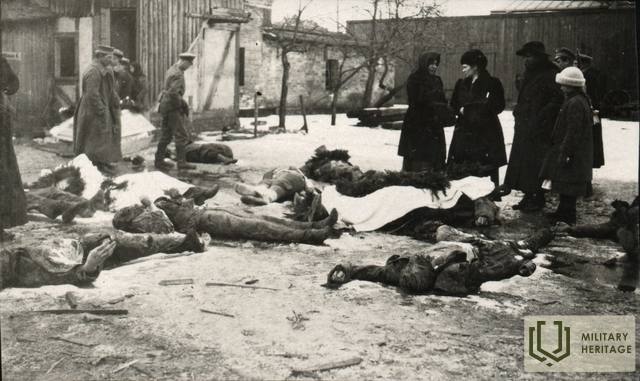
Raudonasis teroras buvo oficiali politika, kurią 1918 m. rugsėjo 5 d. paskelbė valdžioje buvusi bolševikų vyriausybė – Liaudies komisarų taryba (CKP): tikslinis ir teisėtas režimui nepageidaujamų asmenų įkalinimas koncentracijos stovyklose arba fizinis naikinimas be kaltinimų, tyrimo, teismo ar kaltės įrodymų. Raudonasis teroras oficialiai baigėsi lapkričio 6 d., dieną prieš Spalio revoliucijos metines. Tačiau žiaurios represijos prieš tariamus ir tikrus bolševikų režimo priešininkus tęsėsi, o raudonojo teroro pabaiga dažniausiai siejama su Rusijos pilietinio karo pabaiga 1922 m.
Oficiali priežastis buvo nepavykęs socialistų revoliucionierės Fanny Kaplan (1890–1918) pasikėsinimas į Leniną, per kurį bolševikų lyderis buvo sužeistas. Gavęs žinią apie pasikėsinimą į Leniną, Visos Rusijos centrinis vykdomasis komitetas paragino pradėti negailestingą masinį teroro kampaniją prieš revoliucijos priešus. Tačiau oficialų sprendimą pradėti raudonąjį terorą 1919 m. rugsėjo 5 d. priėmė Sovietų Rusijos vyriausybė – Liaudies komisarų taryba (TKP). Pagrindinė institucija, įgyvendinusi raudonąjį terorą, buvo Visos Rusijos ypatingoji komisija ir įvairios jai pavaldžios represinės struktūros, taip pat bolševikų aktyvistai savo iniciatyva. Jau pirmąją raudonojo teroro dieną Petrograde buvo nužudyta daugiau nei 500 režimui nepageidaujamų arba tiesiog „įtartinų“ (pernelyg gerai apsirengusių ar vadinamų inteligentija, karininkais, buvusiais valstybės tarnautojais ar tiesiog turtingais žmonėmis) žmonių. Iš viso per šios politikos metus buvo nužudyta daugiau nei 1 200 000 žmonių.
Vienas iš idėjos autorių ir pagrindinių ideologų buvo žymus čekistas Mārtiņš Lācis (Jānis Sudrabs; 1888–1938), kuris sukūrė ir išpopuliarino šią koncepciją: „Mes nekariaujame prieš atskirus asmenis. Mes naikiname buržuaziją kaip klasę. Tyrimo metu neieškokite medžiagos ir įrodymų, kad kaltinamasis veiksmais ar žodžiais veikė prieš sovietų valdžią. Pirmas klausimas, kurį turėtumėte jam užduoti, yra tai, kokiai klasei jis priklauso, kokia jo kilmė, auklėjimas, išsilavinimas ar profesija. Šie klausimai taip pat turėtų nulemti kaltinamojo likimą. Tai yra raudonojo teroro prasmė ir esmė.“
Kitas latvis, Jēkabs Petersas, 1918 m. rudenį buvo Čekos vadovo Felikso Dzeržinskio pavaduotojas. Tuo metu Čekos aparate dirbo keli šimtai latvių. Kita vertus, tarp bolševikų nužudytųjų taip pat buvo daug latvių, o daugelis, pavyzdžiui, Latvijos laikinosios nacionalinės tarybos nariai, buvo priversti slapstytis arba bėgti iš Rusijos, kad išgelbėtų savo gyvybes. Po bolševikų invazijos į Latviją 1918 m. lapkritį čia taip pat prasidėjo raudonasis teroras, nusinešęs mažiausiai 2–3 tūkstančių žmonių gyvybes. Kiekviename Latvijos rajone bolševikai įsteigė revoliucinius tribunolus; buvo sukurtos kelios koncentracijos stovyklos (didžiausia Pliavinėse); režimui nepageidaujamus asmenis medžiojo bolševikų slaptoji policija – politiniai padaliniai. 1919 m. pavasarį Latvijoje prasidėjo masinės egzekucijos. Tūkstančiai žmonių buvo paimti įkaitais ir uždaryti kalėjimuose, kuriuose tvyrojo nešvara ir siautėjo epideminės ligos (gripas, šiltinė ir kt.).
Daugiau informacijos šaltinių
https://vesture.eu/Sarkanais_terors
https://www.lsm.lv/raksts/dzive--stils/vesture/kas-un-kapec-jazina-par-sarkano-teroru-krievijas-pilsonu-kara-laika.a291271/
https://www.dveseluputenis.lv/lv/laika-skala/notikums/107/bads-un-sarkanais-terors-kurzeme-un-vidzeme/
Susijusi laiko juosta
Susijusios vietos
Paroda KGB pastate „KGB operacijų Latvijoje istorija“
Buvęs SSRS Valstybės saugumo komiteto (paprastai vadinamas Čeka) pastatas atviras lankytojams. Čia čekistai kalindavo, tardydavo ir žudydavo Latvijos piliečius, kuriuos okupacinis režimas laikė priešininkais. Taip pat eksponuojama Latvijos okupacijos muziejaus ekspozicija apie Čekos veiklą Latvijoje. Siūlomos ekskursijos po kalėjimo kameras, koridorius, rūsį ir kiemą. Namas pastatytas 1911 m. ir yra vienas gražiausių pastatų Rygoje. Liaudyje vadinamas „Kampiniu namu“, jis buvo baisiausias sovietinio okupacinio režimo simbolis Latvijoje ir vienas iš SSRS valdžios ramsčių. Čeka iš Kampinio namo veikė okupacijos metu nuo 1940 iki 1941 m., o vėliau nuo 1945 iki 1991 m. Dešimtys tūkstančių latvių nukentėjo nuo tiesioginio politinio persekiojimo. Kova su sovietų valdžios priešais tęsėsi ir po Antrojo pasaulinio karo. Čekos požiūris į savo veiklą šiek tiek pasikeitė po Stalino mirties. Fizinį kankinimą pakeitė psichologinis teroras. Dauguma Čekos agentų buvo latviai (52 %). Antra pagal dydį grupė buvo rusai – 23,7 %. 60,3 % agentų nebuvo Komunistų partijos nariai. 26,9 % agentų turėjo aukštąjį išsilavinimą. Sistema buvo sukurta taip, kad įtrauktų vietos gyventojus ir taip turėtų didesnę kontrolę visuomenėje. Personalo dokumentai ir tarnybos įrašai yra Rusijoje. Ši medžiaga nebuvo prieinama Latvijos valdžios institucijoms ir tyrėjams.
Paminklas žuvusiems Gulbenės parapijos didvyriams už Latvijos laisvę
Įsikūręs istoriniame Gulbenės centre, priešais Gulbenės evangelikų liuteronų bažnyčią.
Paminklas 1905 m. neramumų aukoms, Gulbenės bendruomenės nariams, žuvusiems Pirmajame pasauliniame kare ir Latvijos nepriklausomybės kare, bei Malienos tribunolo aukoms atminti. Paminklą suprojektavo E. Ābeltīns, o 1929 m. jis buvo atidengtas priešais Gulbenės evangelikų liuteronų bažnyčią. Po Antrojo pasaulinio karo ant paminklo buvo pastatyta penkiakampė žvaigždė, o ant jo pagrindo – bronzoje nutapytas gipsinis sovietų kareivio atvaizdas, o už paminklo įrengtos žuvusių sovietų kareivių kapinės. Kai 1969 m. Spārytės parke buvo atidarytos naujos Antrajame pasauliniame kare žuvusių sovietų kareivių kapinės, žuvusiųjų palaikai buvo perkelti į jas, tačiau paminklo vieta sulyginta su žeme. 1989 m. rudenį buvo iškasti paminklo pamatai ir išnešta kapsulė su tekstu, kuri juose buvo įmūryta 1928 m. Paminklas buvo restauruotas 1992 m. (skulptorius O. Feldbergs).
Nuo 1918 m. gruodžio 24 d. iki 1919 m. gegužės 31 d., kai 1-asis (4-asis) Valmieros pėstininkų pulkas išvadavo Gulbenę iš bolševikų, bažnyčioje veikė Malienos (Vecgulbenės) revoliucinis karo tribunolas ir Darbininkų klubas. Jo veikla pasižymėjo griežtais sprendimais ir dideliu mirties bausmių skaičiumi, dažnai už smulkius nusikaltimus – buvo ištirtos 349 bylos, kuriose kaltinami 606 asmenys.
Matoma memorialinė skulptūra.
Trėmimams naudotas galvijinis vagonas – muziejus Skrundos geležinkelio stotyje
1941 m. birželio ir 1949 m. kovo mėn. trėmimams atminti Skrundos geležinkelio stotyje pastatytas atminimo akmuo ir keturašis vagonas, kuris taip pat tarnauja kaip trėmimams skirtas muziejus. Tai pirmasis vagono tipo muziejus Latvijoje, kuriame nuolat eksponuojamos iš Skrundos stoties ištremtų žmonių nuotraukos, laiškai, atsiminimai, dokumentai ir įvairūs daiktai. Skrundos stotis buvo tremtinių surinkimo vieta ir viena iš trijų regiono stočių, į kurią buvo atvežti žmonės iš Skrundos ir Kuldygos apylinkių. 1941 m. iš čia į Krasnojarsko kraštą Sibire buvo ištremta pirmojo atkurtos Latvijos Respublikos prezidento Gunčio Ulmanio šeima.
Deportacijų pagalba sovietai susidorojo su nacionalinių partizanų šalininkais ir tuo pačiu metu baugino likusius kaimo gyventojus, versdami juos stoti į kolūkius.
Paroda „Latvijos armija Pliavinėse XX amžiuje“.
Adresas: Odzienas g. 2, Pļavinės.
Eksponuojama nuolatinė ekspozicija „Latvijos armija Pliavinėse XX amžiuje“.
Pastatas Pliavinėse, Odzienos gatvėje 2, turi ilgą istoriją – nuo tada, kai „Stukmaņi“ didmenininkas „Hugo Apeltofts“ pradėjo jame aktyvią ūkinę veiklą ir taip prisidėjo prie Pliavinių miesto plėtros, iki to momento, kai Nepriklausomybės karo metu čia buvo įkurtas Latvijos Rytų fronto štabas. 1919 m. būtent iš Pliavinių buvo vadovaujamos Latvijos armijos dalinių operacijos prieš Raudonąją armiją Latgaloje.
1934 m. prie šių namų buvo atidengta memorialinė lenta su užrašu: „1919 m. šiuose namuose buvo įsikūręs Rytų fronto štabas, o čia generolas Janis Balodis perėmė vyriausiąją Latvijos nacionalinės armijos vadovybę.“ Sovietų valdžia ją 1940 m. pašalino ir sunaikino, tačiau 1990 m. birželio 16 d., padedant Latvijos nacionalinės išlaisvinimo armijos Pliavinės skyriui, ji buvo atstatyta.
Dabar šalia buvusio štabo pastato stovi memorialinė stela, skirta 15 Lačplėsio Karo ordino riterių, gimusių Pliavinos krašte, o patalpose sukurta paroda „Latvijos armija Pliavinoje XX amžiuje“, kurioje pasakojama apie Laisvės kovų įvykius, Latvijos armijos 3-iosios Latgalos divizijos štabo veiklą Pliavinoje, taip pat galima susipažinti su Lačplėsio Karo ordino riterių gyvenimo istorijomis.
Netoli parodų pastato yra Latgalos divizijos štabo pastatas, kurį 1913 m. kaip „Stukmanu“ likerio fabriką pastatė grafas Teodoras Medemas. 1919 m. jį perėmė P. Stučkos režimas, kuriame taip pat buvo įkurtas kalėjimas. Išvijus bolševikus, 1925 m. pastatą perėmė Latvijos armija, kurioje buvo įsikūręs Latgalos divizijos štabas. Šiame pastate savo karinę karjerą praleido 10 Latvijos armijos generolų ir kitų karininkų. 1940 m. pastatą perėmė Raudonoji armija. Pokario metais jame buvo įsikūrusi mokykla, taip pat savivaldybė. Apie 1970 m. pastatą pradėjo naudoti gamybos susivienijimas „Rīgas Apērbs“.
Parodą būtina apžiūrėti iš anksto telefonu 28442692.
Latgalos kultūros istorijos muziejus
Latgalos kultūros istorijos muziejuje Rėzeknėje veikia trys nuolatinės ekspozicijos. Viena jų – „Rėzeknė laikmečių sandūroje“ – pasakoja apie daugiau kaip septynis šimtmečius besitęsiančią miesto istoriją. Didelė ekspozicijos dalis skirta XX a. įvykiams, karams ir besikeitusiems laikotarpiams: Pirmasis pasaulinis karas, Nepriklausomybės karas, Antrasis pasaulinis karas, 1944 m. sovietų bombonešių antskrydis, taip pat karo belaisvių stovykla „Stalag 347“. Ekspozicijoje yra fotografijų stendas, skirtas Rėzeknės kareivių likimams karo metais.
Latvijos nepriklausomybės laikais Rėzeknėje buvo dislokuotas Latvijos kariuomenės 9-asis Rėzeknės pėstininkų pulkas, kuris tapo neatsiejama miesto visuomeninio gyvenimo ir sporto renginių dalimi – ypač per lapkričio 11 d. (Laisvės gynėjų dienos) ir lapkričio 18 d. (Latvijos nepriklausomybės dienos) minėjimus.




